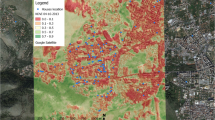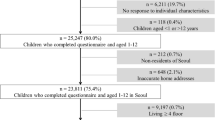Abstract
This study aimed to assess the air quality, the prevalence of child respiratory morbidity, and the association between them, in urban areas where concentrations of pollutants are expected to be below national limits. The monitoring of PM10, NO2 and O3 was performed in five schools, during 9 months. Information about respiratory diseases and associated symptoms were collected from each student using a questionnaire based on the International Study of Asthma and Allergies in Childhood. The PM10 and NO2 concentrations were higher at points closer to roads and avenues with intense vehicle flow and lower at the point closer to a park, with dense vegetation. All sampling points exceeded the annual limit established by WHO for PM10. Some maximum PM10 concentrations recorded close to the road was six times higher than the international limit. In total, 340 answered questionnaires were collected (68% response rate). Respiratory symptoms such as wheezing, sneezing, running nose, tearing, and itchy eyes had positive and strong correlation to the primary pollutants (0.70 to 0.87), but the frequency of some symptoms was lower close to the urban forest. Therefore, our results confirm the importance of creating and maintaining green areas in urban space, considering all ecosystem services provided by them, especially the improvement of air quality. In addition, a continuous program to monitor and control atmospheric pollution is required in mid-sized counties located nearby important roads, with growing fleets of vehicles.

Similar content being viewed by others
References
Ali, M., & Athar, M. (2008). Air pollution due to traffic, air quality monitoring along three sections of National Highway N-5, Pakistan. Environmental Monitoring and Assessment, 136(1–3), 219–226.
Brazil. (2018). National Council of the Environment. Resolução Conama n° 491 – de 21 de novembro de 2018. Dispõe sobre os padrões de qualidade do ar. Diário Oficial da União. Brasília.
Brazil. (2019). National Traffic Department (Denatran). National fleet by municipality. http://www.denatran.gov.br/estatistica/635-frota-2018.
Escobedo, F. J., Kroeger, T., & Wagner, J. E. (2011). Urban forests and pollution mitigation: analyzing ecosystem services and disservices. Environmental Pollution, 159(8–9), 2078–2087.
Fajersztajn, L., Veras, M., Barrozo, L. V., & Saldivaet, P. (2013). Air pollution: a potentially modifiable risk factor for lung cancer. Nature Reviews, 13, 674–679.
Farokhi, A., Heederik, D., & Smit, L. A. M. (2018). Respiratory health effects of exposure to low levels of airborne endotoxin – a systematic review. Environmental Health, 17(14).
Feng, W., Li, H., Wanga, S., Halm-Lutterodt, N. V., An, J., Liu, Y., et al. (2019). Short-term PM10 and emergency department admissions for selective cardiovascular and respiratory diseases in Beijing, China. Science of the Total Environment, 657, 213–221.
Garcia, G., Allen, A. G., & Cardoso, A. A. (2010). Development of a sensitive passive sampler using indigo trisulfonate for the determination of tropospheric ozone. Journal of Environmental Monitoring, 12, 1325–1329.
Ghaedrahmat, Z., Vosoughi, M., Birgani, Y. T., Neisi, A., Goudarzi, G., & Takdastan, A. (2019). Prediction of O3 in the respiratory system of children using the artificial neural network model and with selection of input based on gamma test, Ahvaz, Iran. Environmental Science and Pollution Research, 26(11), 10941–10950.
Goudarzi, G., Geravandi, S., Foruozandeh, H., Babaei, A. A., Alavi, N., Niri, M. V., et al. (2015). Cardiovascular and respiratory mortality attributed to ground-level ozone in Ahvaz, Iran. Environmental Monitoring and Assessment, 187, 487.
Guo, C., Zhang, Z., Lau, A. K. H., Lin, C. Q., Chuang, Y. Z., Chan, J., et al. (2018). Effect of long-term exposure to fine particulate matter on lung function decline and risk of chronic obstructive pulmonary disease in Taiwan: a longitudinal, cohort study. The Lancet Planetary Health, 2(3), 114–125.
IBGE. (2019). Brazilian Institute of Geography and Statistics. Cities. http://www.ibge.gov.br/cidadesat/link.php?codigo=317010. .
INMET. (2016). National Institute of meteorology. Graphics: Uberaba – MG, 2016. http://www.inmet.gov.br/sim/gera_graficos.php. .
Janhall, S. (2015). Review on urban vegetation and particle air pollution – deposition and dispersion. Atmospheric Environment, 105, 130–137.
Jung, D. Y., Leem, J. H., Kim, H. C., Kim, J. H., Hwang, S. S., Lee, J. Y., Kim, B. J., Hong, Y. C., Hong, S. J., & Kwon, H. J. (2015). Effect of traffic-related air pollution on allergic disease: results of the children’s health and environmental research. Allergy, Asthma & Immunology Research, 7(4), 359–366.
Khaniabadi, Y. O., Goudarzi, G., Daryanoosh, S. M., Borgini, A., Tittarelli, A., & De Marco, A. (2017). Exposure to PM10, NO2, and O3 and impacts on human health. Environmental Science and Pollution Research, 24(3), 2781–2789.
Köppen-Geiger. (2019). Climate classification of Koppen-Geiger. https://portais.ufg.br/up/68/o/Classifica____o_Clim__tica_Koppen.pdf. .
Landrigan, P. L., Fuller, R., Fisher, S., Suk, W. A., Sly, P., Chiles, T. C., & O'Reilly, S. (2019). Pollution and children’s health. Science of the Total Environment, 650, 2389–2394.
Livesley, S. L., McPherson, E. G., & Calfapietra, C. (2016). The urban forest and ecosystem services: impacts on urban water, heat, and pollution cycles at the tree, street, and city scale. Journal of Environmental Quality, 11, 119–124 BoseG.
Melchert, W. R., & Cardoso, A. A. (2006). Construção de amostrador passivo de baixo custo para determinação de dióxido de nitrogênio. Química Nova, 29(2), 365–367.
McBride, D. L. (2015). Children's Lung Health Improves With Reduced Air Pollution. Journal of Pediatric Nursing, 30(4), 624-625.
Monks, P. (2018). Impacts of vegetation on urban air pollution. Air Quality Expert Group to the Department for Environment, Food and Rural Affairs; Scottish Government; Welsh Government; and Department of the Environment in Northern Ireland. https://uk-air.defra.gov.uk/assets/documents/reports/cat09/1807251306_180509_Effects_of_vegetation_on_urban_air_pollution_v12_final.pdf. .
Nakhlé, M. M., Farah, W., Ziadé, N., Abboud, M., Salameh, D., & Annesi-Maesano, I. (2015). Short-term relationships between emergency hospital admissions for respiratory and cardiovascular diseases and fine particulate air pollution in Beirut, Lebanon. Environmental Monitoring and Assessment, 187(196).
Nicolussi, F. H., Santos, A. P. M., André, S. C. S., Veiga, T. B., & Takayanagui, A. M. M. (2014). Poluição do ar e doenças respiratórias alérgicas em escolares. Revista de Saúde Pública, 48(2), 326–330.
Pao, H. T., & Tsai, C. H. (2011). Multivariate granger causality between CO2 emissions, energy consumption. Foreign direct investment and gross domestic product: evidence from a panel of BRIC (Brazil, Russian Federation, India and China) countries. Energy, 36(1), 685–693.
Prüss-Üstün, A., Wolf, J., Corvalán, C., Boss, R., & Neira, M. (2016). Preventing disease through healthy environments: a global assessment of the burden of disease from environmental risks. Paris: World Health Organization Press.
Rocha, J. C., Rosa, A. H., & Cardoso, A. A. (2009). Introdução a Química Ambiental (2nd ed.). Porto Alegre: Bookman.
Santos, A. P. M., Passuello, A. P., Schuhmachercd, M., Nadal, M., Domingo, J. L., Martinez, C. A., et al. (2014). A support tool for air pollution health risk management in emerging countries: a case in Brazil. Human and Ecological Risk Assessment, 20(5), 1406–1424.
Seinfeld, J. H., & Pandis, S. N. (2016). Atmospheric chemistry and physic: from air pollution to climate change (3rd ed.). New York: John D. Wiley & Sons.
Sheffield, P. E., Zhou, J., Shmool, J. L., & Clougherty, J. E. (2015). Ambient ozone exposure and children’s acute asthma in New York City: a case-crossover analysis. Environmental Health, 14(25).
Sunyer, J., Esnaola, M., Alvarez-Pedrerol, M., Forns, J., Rivas, I., López-Vicente, M., Suades-González, E., Foraster, M., Garcia-Esteban, R., Basagaña, X., Viana, M., Cirach, M., Moreno, T., Alastuey, A., Sebastian-Galles, N., Nieuwenhuijsen, M., & Querol, X. (2015). Association between traffic-related air pollution in schools and cognitive development in primary school children: a prospective cohort study. PLoS Medicine, 12(3), e1001792.
Torres, F. T. P. (2008). Introdução à climatologia. São Paulo: Cengage.
Wang, S., Zhang, J., Zeng, X., Zeng, Y., Wang, S., & Chen, S. (2009). Association of traffic-related air pollution with children’s neurobehavioral functions in Quanzhou, China. Environmental Health Perspectives, 117(10), 1612–1618.
WHO. (2006). World Health Organization. Air quality guidelines. Global update 2005: summary of risk assessment. WHO Press. http://www.who.int/phe/health_topics/outdoorair_aqg/en/. .
WHO. (2018). World Health Organization. Ambient (outdoor) air quality and health. http://www.who.int/mediacentre/factsheets/fs313/en/. .
WHO. (2019). World health organization. Air pollution and child health: prescribing clean air. https://www.who.int/ceh/publications/air-pollution-child-health/en/.
Funding
Brazilian National Council for Scientific and Technological Development (CNPq) and the Minas Gerais State Agency for Research and Development (Fapemig) provided financial support for the research.
Author information
Authors and Affiliations
Corresponding author
Ethics declarations
The study was performed after its approval by the Research Ethics Committee of Federal University of Triangulo Mineiro (Approval n. 54412216.0.0000.5154).
Additional information
Publisher’s note
Springer Nature remains neutral with regard to jurisdictional claims in published maps and institutional affiliations.
Appendices
Appendix 1 Calibration curve for NO2

Appendix 2 Calibration curve for indigo blue

Rights and permissions
About this article
Cite this article
e Almeida, L.d.O., Favaro, A., Raimundo-Costa, W. et al. Influence of urban forest on traffic air pollution and children respiratory health. Environ Monit Assess 192, 175 (2020). https://doi.org/10.1007/s10661-020-8142-4
Received:
Accepted:
Published:
DOI: https://doi.org/10.1007/s10661-020-8142-4




